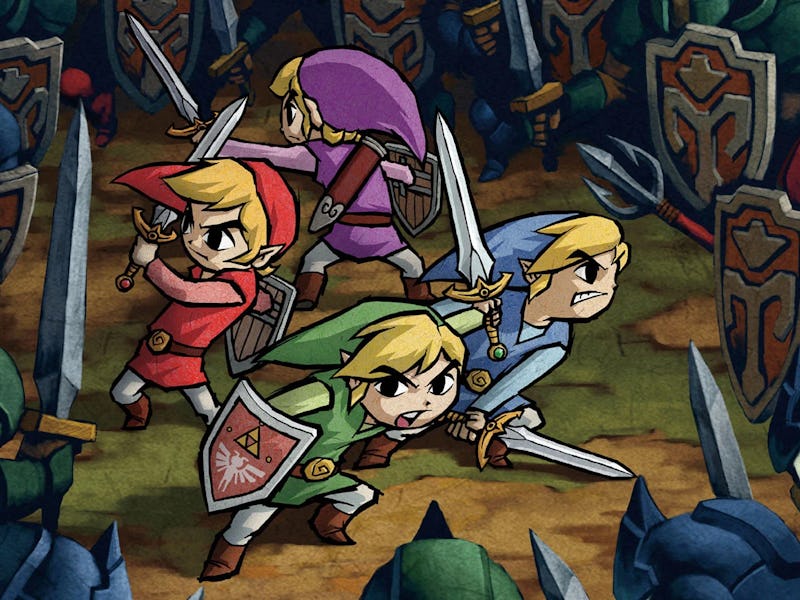Four Swords Adventures Was a Costly but Brilliant Experiment From Nintendo
How many Links is too many?

If you’ve played one Legend of Zelda game, you know the premise for almost all of them. Ganondorf — or occasionally a substitute villain — is threatening the kingdom of Hyrule, and only the lone swordsman Link can stop him. Well, except for that one time when it took four Links to stop him. Nintendo has experimented a lot with The Legend of Zelda over the years, but it’s rarely made something as risky as Four Swords Adventures, a one to four-player GameCube adventure that celebrates its North American launch anniversary this week.
In 2002, A Link to the Past for the Game Boy Advance included the multiplayer mode Four Swords, which let two to four players make their way through dungeons together while racing to collect more rupees than their pals. Two years later, that idea would be expanded into a full game with Four Swords Adventures, which launched on March 18 in Japan before coming to North America on June 7.
Why settle for one Link when you could have four?
Nintendo being Nintendo, its multiplayer Zelda experiment was more interesting and far less simple than it could have been. In the game’s story, Link has been split into four parts, each with a different colored tunic. Rather than four players teaming up with their own GameCube controller, each player uses a separate Game Boy Advance hooked up to the console with a link cable to control their own individual Link (I don’t think Nintendo meant that as a pun). It may sound like requiring multiple consoles would make Four Swords Adventures a pretty expensive game to play — and it was! Nintendo hasn’t released official figures, but Four Swords Adventures is reportedly the worst-selling game in the series, moving fewer than one million units over its lifetime.
That’s not surprising for a game that basically requires four players with their own Game Boy Advances to get the most out of the experience, but it doesn’t mean that Four Swords Adventures has nothing to offer. While its puzzles were generally a bit simpler than those in the series’ best installments, they did make novel use of the multiplayer format by requiring the Links to split up and perform actions in tandem, which is something other Legend of Zelda games can’t do.
The best part of Four Swords Adventures, though, is how it uses its gimmicky Game Boy Advance connection. While it may not stack up to the GameCube controller when it comes to comfort, the Game Boy Advance does have a huge advantage over a traditional controller — its screen. Most of the time, all four Links play on the same screen, just like in many other multiplayer games. But when one player splits off to explore or tackle a different challenge from the others, their character moves to their corresponding Game Boy Advance screen, rather than using a traditional splitscreen format. That means that the players who choose to stick together get the advantage of a whole TV screen, while stray players get to have their own handheld adventure.
Four Swords Adventures turns The Legend of Zelda into a novel co-op quest.
It’s debatable whether that feature makes up for Four Swords Adventures’ other drawbacks, but there’s no denying it's a novel way to approach a multiplayer game. It’s also one of the cleverest uses of the link cable that connects the Game Boy Advance to the GameCube. Dozens of games used the link cable, but many of them just let the handheld be used as a controller, enabled special minigames, or displayed information like scores and minimaps. Four Swords Adventures instead lets players enjoy both a shared game on the main screen and small personal adventures of the Game Boy Advance, offering the best of multiplayer and single-player gaming at the same time.
The unpopularity of Four Swords Adventures and the link cable in general may be predictable, but it still feels unfortunate. Sure, on some level, pushing players to buy a GameCube, a Game Boy Advance, and a link cable accessory just to get the most out of games was motivated by Nintendo trying to get as much money out of them as possible. But it still led to some genuinely innovative gameplay that you just can’t get any other way. Besides, publishers are still finding ways to extract as much cash as possible from players today, and most of them are far less interesting than what Four Swords Adventures did.
Nintendo is still invested in longshot experiments more than other console makers, whether it’s launching a hybrid handheld console, releasing a cardboard VR accessory, or finding a way to turn an exercise app into an RPG. But there’s something a little more special about Four Swords Adventures, which didn’t just introduce a novel gameplay idea, it gave groups of people a new way to play together, even if it was just by letting their adventure jump seamlessly from the TV screen into their hands.